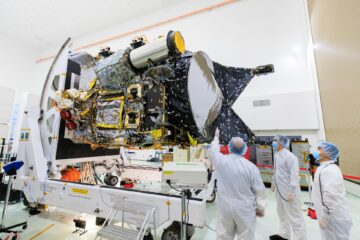
With the year almost in the books, we’re taking a look at Singularity Hub’s most-read articles in 2023.
There’s no doubt the year belonged to AI, and coverage of DeepMind’s definition of artificial general intelligence, one of the field’s most controversial topics, grabbed readers’ attention. But AI didn’t dominate the list. Amid high interest rates, expensive homes, and inflation, the future of housing—a 3D printed house that could cost as little as a car—and energy—kickstarting the world’s biggest fusion reactor—were on people’s minds. Discoveries in longevity and the neuroscience of cognition, memory, and creativity—AI-adjacent topics—likewise struck a chord. And even as metaverse news faded, a story on the rapid democratization of 3D scanning technologies sparked the imagination.
It was another wild year in science and tech. As always, thanks for reading!
This 3D-Printed House Goes Up in 2 Days and Costs the Same as a Car
By Vanessa Bates Ramirez
“3D printing is becoming more popular as a construction method, with multiple companies building entire 3D-printed neighborhoods in various parts of the world. But the technique has come under scrutiny, with critics saying it’s not nearly as cost-effective nor environmentally friendly as advocates claim. A Japanese company called Serendix is hoping to be a case to the contrary; the company is 3D printing tiny homes that cost just $37,600.”
Scientists Find the Source of a Mysterious Brain Wave That Could Boost Memory and Creativity
By Shelly Fan
“For decades, [theta waves] waves have taunted neuroscientists trying to decipher their functions. [They] seem to help mice navigate mazes, but also support memory in humans. It’s not just academic curiosity. Our ability to navigate complex new environments and keep those memories declines with age. It’s especially tough for people with Alzheimer’s disease. By finding the source of theta waves, we could potentially enhance them—using neurostimulation or other methods—to slow cognitive decline.”
Newly Discovered Spirals of Brain Activity May Help Explain Cognition
By Shelly Fan
“For the cortex to properly function, communication between each region is key. In a series of tests, brain spirals seem to be the messenger, organizing local neural networks across the cortex into a coherent computing processor. …By analyzing these spiral wave fingerprints, the team found they could classify different stages of cognitive processing using brain images alone. Finding turbulence in the brain is another step towards understanding how our biological computer works and could inspire the creation of future brain-based machines.”
Scientists Fire Up the World’s Largest Fusion Reactor for the First Time
By Edd Gent
“[In October], scientists working on the JT-60SA experimental reactor at the National Institutes for Quantum Science and Technology in the city of Naka achieved ‘first plasma,’ according to Science. That effectively means the machine was successfully switched on but is still a long way from carrying out meaningful tests or producing any power. Nonetheless, it’s a significant milestone for a reactor meant to pave the way for the much larger ITER reactor being built in France, which is expected to be the first of its kind to generate more power than it uses.”
Scientists Studied 348 Mammals to Discover Why Some Live for Months While Others Last Centuries
By Shelly Fan
“The tour-de-force study, published [in Science], covered nearly 15,500 samples from 348 mammalian species both small and large. The entire animal register looks like the population of an international zoo. …There’s a reason for analyzing the animal kingdom in all its glorious diversity. By studying mammals using the same biological clock and comparing each profile, we can begin to parse genomic ‘hot spots’ that govern aging and lifespan, in turn homing in on methods to regulate those spots and delay or even reverse the aging process.”
This Longevity Study Across 5 Species Found a New Pathway to Reverse Aging
By Shelly Fan
“…Scientists have long suspected that [DNA] transcription may go awry with aging, but the new study offers proof that it doesn’t—with a twist. In all five of the species tested, as the organism grew older the process surprisingly sped up. But like trying to type faster when blindfolded, error rates also shot up. There’s a fix. Using two interventions known to extend lifespan, the team was able to slow down transcription in multiple species, including mice. Genetic mutations that reversed the sloppy transcription also extended lifespan in worms and fruit flies, and boosted human cells’ ability to divide and grow.”
This 3D Printed Community Is Printing One House per Week for a Year
By Vanessa Bates Ramirez
“3D printing has been slowly but surely ramping up as a viable construction technology, with communities of 3D printed homes being built in California, Virginia, Texas, and Mexico, among others. Now a new development on the other side of the Atlantic is joining this list. 14Trees, a joint venture between Swiss sustainable construction company Holcim and British International Investment, announced completion of the first 10 units of a 3D printed housing project in Kilifi, Kenya. The community is called Mvule Gardens, and it will eventually consist of 52 single-family homes.”
DeepMind Defines Artificial General Intelligence and Ranks Today’s Leading Chatbots
By Edd Gent
“What exactly people mean by AGI is rarely specified, and the idea is frequently described in binary terms, where AGI represents a piece of software that has crossed some mythical boundary, and once on the other side, it’s on par with humans. Researchers at Google DeepMind are now attempting to make the discussion more precise by concretely defining the term. Crucially, they suggest that rather than approaching AGI as an end goal, we should instead think about different levels of AGI, with today’s leading chatbots representing the first rung on the ladder.”
A Revolution in Computer Graphics Is Bringing 3D Reality Capture to the Masses
By Aaron Frank
“Backup Ukraine, a collaborative project between the Danish UNESCO National Commission and Polycam, a 3D creation tool, enables anyone equipped with only a phone to scan and capture high-quality, detailed, and photorealistic 3D models of heritage sites, something only possible with expensive and burdensome equipment just a few years ago. Backup Ukraine is a notable expression of the stunning speed with which 3D capture and graphics technologies are progressing, according to Bilawal Sidhu, a technologist, angel investor, and former Google product manager who worked on 3D maps and AR/VR. ‘Reality capture technologies are on a staggering exponential curve of democratization,’ he explained to me in an interview for Singularity Hub.”
Energy Vault’s First Grid-Scale Gravity Energy Storage System Is Near Complete
By Vanessa Bates Ramirez
“Energy Vault’s solid gravity system uses huge, heavy blocks made of concrete and composite material and lifts them up in the air with a mechanical crane. The cranes are powered by excess energy from the grid, which might be created on very sunny or windy days when there’s not a lot of demand. The blocks are suspended at elevation until supply starts to fall short of demand, and when they’re lowered down their weight pulls cables that spin turbines and generate electricity.”
Image Credit: ilgmyzin / Unsplash
- SEO Powered Content & PR Distribution. Get Amplified Today.
- PlatoData.Network Vertical Generative Ai. Empower Yourself. Access Here.
- PlatoAiStream. Web3 Intelligence. Knowledge Amplified. Access Here.
- PlatoESG. Carbon, CleanTech, Energy, Environment, Solar, Waste Management. Access Here.
- PlatoHealth. Biotech and Clinical Trials Intelligence. Access Here.
- Source: https://singularityhub.com/2023/12/23/these-were-the-10-most-popular-singularity-hub-stories-of-2023/
- :has
- :is
- :not
- :where
- $UP
- 10
- 15%
- 2023
- 3d
- 3D Printing
- 500
- a
- Aaron
- ability
- Able
- About
- academic
- According
- achieved
- across
- activity
- advocates
- age
- AGI
- Aging
- ago
- AI
- AIR
- All
- almost
- alone
- also
- always
- Alzheimer’s
- Amid
- among
- an
- analyzing
- and
- Angel
- Angel Investor
- animal
- announced
- Another
- any
- anyone
- approaching
- AR/VR
- ARE
- articles
- artificial
- artificial general intelligence
- AS
- At
- attempting
- attention
- Backup
- BE
- becoming
- been
- begin
- being
- between
- Biggest
- Blocks
- Books
- boost
- Boosted
- both
- Brain
- Brain activity
- Bringing
- British
- built
- but
- by
- cables
- california
- called
- CAN
- capture
- carrying
- case
- chatbots
- City
- claim
- Classify
- Clock
- cognition
- cognitive
- COHERENT
- collaborative
- come
- commission
- Communication
- Communities
- community
- company
- comparing
- completion
- complex
- computer
- computer graphics
- computing
- construction
- contrary
- controversial
- cortex
- Cost
- cost-effective
- Costs
- could
- coverage
- covered
- created
- creation
- credit
- Critics
- Crossed
- crucially
- curiosity
- curve
- danish
- Days
- decades
- Decipher
- Decline
- Declines
- DeepMind
- Defines
- defining
- definition
- delay
- Demand
- democratization
- described
- detailed
- Development
- different
- discover
- discovered
- discussion
- Disease
- Diversity
- divide
- dna
- dominate
- doubt
- down
- each
- effectively
- electricity
- enables
- end
- energy
- enhance
- Entire
- environmentally
- environmentally friendly
- environments
- equipment
- equipped
- error
- especially
- Even
- eventually
- exactly
- excess
- expected
- expensive
- experimental
- Explain
- explained
- exponential
- expression
- extend
- Fall
- faster
- few
- Find
- finding
- Fire
- First
- five
- Fix
- For
- Former
- found
- France
- frequently
- friendly
- from
- function
- functions
- fusion
- future
- Gardens
- General
- general intelligence
- generate
- genetic
- Go
- goal
- Goes
- govern
- graphics
- gravity
- grew
- Grid
- Grow
- Have
- he
- heavy
- help
- heritage
- High
- high-quality
- Homes
- hoping
- House
- housing
- How
- HTTPS
- Hub
- huge
- human
- Humans
- idea
- images
- imagination
- in
- Including
- inflation
- inspire
- instead
- Intelligence
- interest
- Interest Rates
- International
- interventions
- Interview
- into
- investment
- investor
- IT
- ITS
- Japanese
- joining
- joint
- joint venture
- just
- Keep
- kenya
- Key
- Kind
- Kingdom
- known
- ladder
- large
- larger
- largest
- Last
- leading
- levels
- lifespan
- like
- List
- little
- live
- local
- Long
- longevity
- Look
- LOOKS
- Lot
- lowered
- machine
- Machines
- made
- make
- manager
- Maps
- material
- May..
- me
- mean
- meaningful
- means
- meant
- mechanical
- Memories
- Memory
- Messenger
- Metaverse
- metaverse news
- method
- methods
- Mexico
- mice
- might
- milestone
- minds
- models
- months
- more
- most
- Most Popular
- much
- multiple
- mysterious
- National
- Navigate
- Near
- nearly
- networks
- Neural
- neural networks
- Neuroscience
- New
- news
- no
- nor
- notable
- now
- october
- of
- Offers
- older
- on
- once
- ONE
- only
- or
- organizing
- Other
- Others
- our
- out
- parts
- pathway
- pave
- People
- people’s
- per
- phone
- Photorealistic
- piece
- Plasma
- plato
- Plato Data Intelligence
- PlatoData
- Popular
- population
- possible
- potentially
- power
- powered
- precise
- printing
- process
- processing
- Processor
- producing
- Product
- product manager
- Profile
- progressing
- project
- proof
- properly
- published
- Pulls
- Quantum
- ramping
- ranks
- rapid
- rarely
- Rates
- rather
- reactor
- Reality
- reason
- region
- register
- Regulate
- representing
- represents
- researchers
- reverse
- Revolution
- same
- saying
- scan
- scanning
- Science
- Science and Technology
- scientists
- scrutiny
- seem
- Series
- Short
- shot
- should
- side
- significant
- singularity
- Singularity Hub
- Sites
- slow
- Slowly
- small
- Software
- solid
- some
- something
- Source
- sparked
- specified
- speed
- Spin
- spots
- stages
- staggering
- starts
- Step
- Still
- storage
- Stories
- Story
- studied
- Study
- Studying
- Stunning
- Successfully
- suggest
- supply
- support
- surely
- suspected
- suspended
- sustainable
- Swiss
- switched
- system
- taking
- team
- tech
- technique
- Technologies
- technologist
- Technology
- term
- terms
- tested
- tests
- texas
- than
- thanks
- that
- The
- The Future
- The Source
- the world
- their
- Them
- These
- Theta
- they
- Think
- this
- those
- to
- today’s
- tool
- Topics
- tough
- towards
- trying
- turbulence
- TURN
- twist
- two
- type
- Ukraine
- under
- understanding
- units
- until
- uses
- using
- venture
- very
- viable
- virginia
- was
- Wave
- waves
- Way..
- we
- week
- weight
- were
- when
- which
- while
- WHO
- why
- Wild
- will
- with
- worked
- working
- works
- world
- world’s
- worms
- year
- years
- zephyrnet
- ZOO







